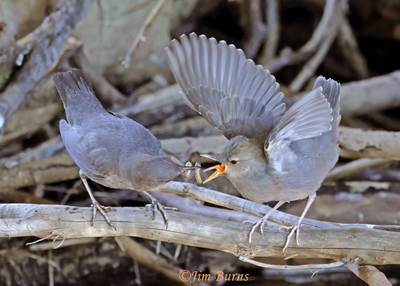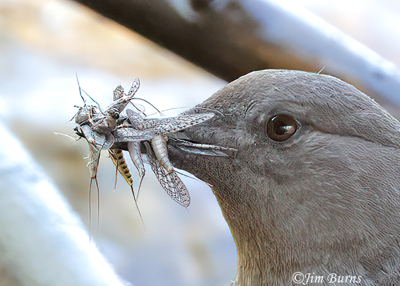
It has been a long but rewarding morning spent with one of North America’s most unique and interesting avian species, but I may not have much to show for it photographically because the bright upstream background to the gloom of the family’s territory beneath the bridge presents an exposure nightmare for the camera. The fledgling is the first young dipper I’ve ever seen, and though it is probably less than a week out of the nest, it is already completely at home in its watery world.
Dippers are our only aquatic passerine, exquisitely evolved for life in and near cold, rushing waters, and the two characteristic and fascinating behaviors for which the species is known are both on full display in front of me. These are, of course, the near constant full body dipping motion similar to a Rock Wren’s “push-ups,” and the periodic blinking which flashes the white feathers on the upper and lower eyelids. I can duly attest that dippers do not dip when at rest, and that the white flashes are not from their nictitating eye membranes.
Researchers have yet to definitively prove the purpose of either of these unique behaviors, but there are logical explanations. Dippers live with their monochrome slate gray plumage in a world that is mostly dark and shadowed amidst the cacophony of rushing, falling water. The white flashes are thought to be a form of silent communication, or at least visual contact, and the dipping may serve the same purpose or it may be a method of visual triangulation to help see and capture their prey in a habitat that is continually in frenetic motion.
American Dippers have three well researched and proven evolutionary adaptations that allow for survival in that habitat. Compared to land based birds, dippers have a lower than average metabolic rate, a higher than average blood oxygen capacity, and a preen gland at the base of the tail which, like that of other water birds, produces copious amounts of oil for maintenance of feathers almost constantly wet.
The dipper song, wren-like to my ear, is a loud, piercing jumble of musical notes and phrases, seemingly more reverberative when the singer faces away from the water toward the rock wall. This may be yet another adaptive behavior, an echo effect, which allows for the species’ communications to rise above the din of the rushing streams where they live. Both sexes sing the same songs.
One of my goals for the morning has been to document the prey items captured and brought to the young. I consider this mission accomplished, though I cannot name to species level the one small fish or the myriad aquatic larvae, worms, and flying insects I have seen the parents bring, often so many in a single trip that the bill itself cannot be seen for the cluster of food sprouting from it. The literature indicates Caddisflies and their larvae are favorite items, but identifying wet, mangled bugs is well beyond my level of entomological expertise. Both parents have been bringing mouthfuls of this protein at fifteen minute intervals.
Arrivals are seldom at the same time and are accompanied by raucous screeching and squawking, primarily from the young bird already out of the nest and tentatively exploring on its own the waters splashing through the detritus from spring flooding and the beavers’ handiwork. Periodically both adult birds take a respite atop a log to sing and meticulously preen. Departures are both upstream and downstream, never the same way by both birds.
Their flight paths always follow the bends and braids of the stream itself, with no shortcuts over dry land. Undoubtedly this facilitates maximum efficiency for finding prey items while precluding predation from accipiters. The parents foraging efforts are equally divided between swimming with the head underwater, diving under logs, and poking around the edges of rocks and boulders in the stream. On a few occasions I watched them picking on the ground among leaves and pine needles like sparrows or quail.
American Dippers are much more common in the northern Rockies and the Pacific Northwest than here in the arid Southwest. Arizona birders, upon encountering John Muir’s “water thrush,” should take the time to linger and observe this very distinctive and special species, if for no other reason than to enjoy the ebullient song reflective of their lifestyle. Here’s what Muir had to say about that—
[H]is music is that of the streams refined and spiritualized. The deep booming notes of the falls are in it, the trills of the rapids, the gurgling of margin eddies, the low whispering of level reaches, and the sweet tinkle of separate drops oozing from the ends of mosses and falling into tranquil ponds."
Indeed!
